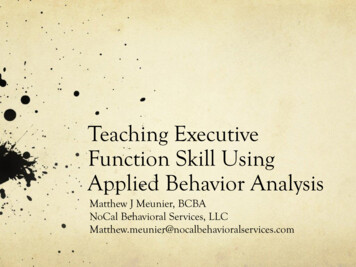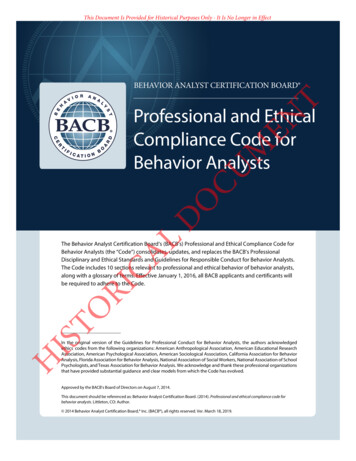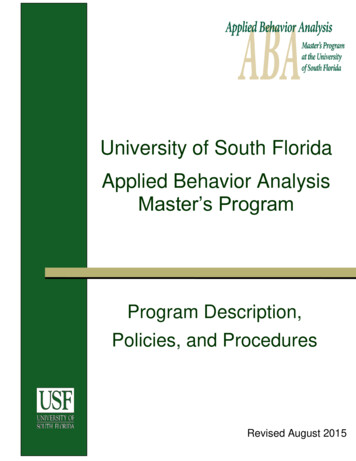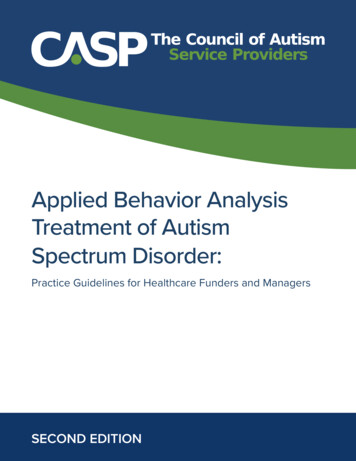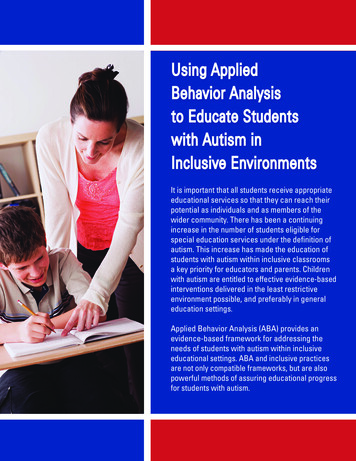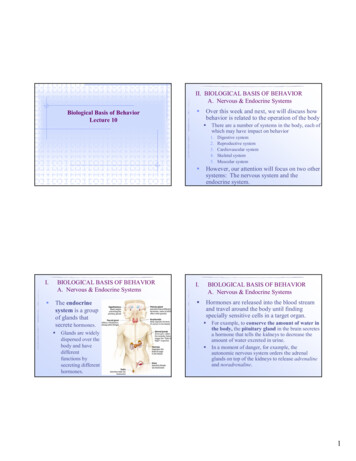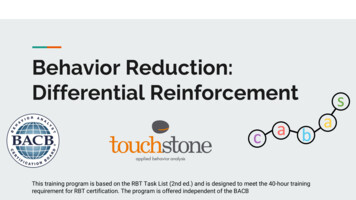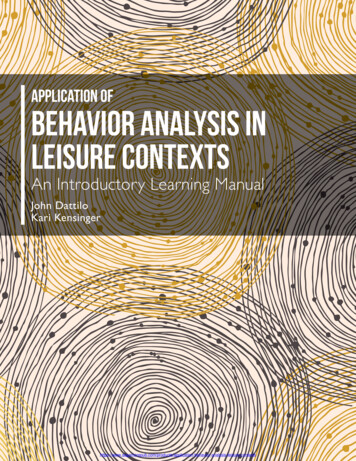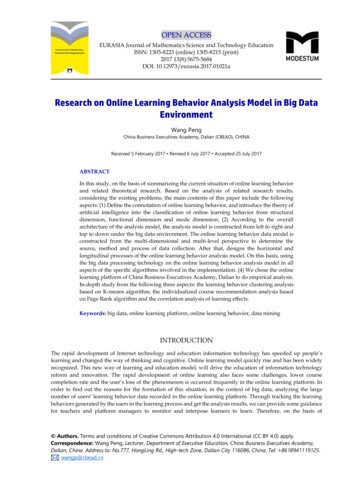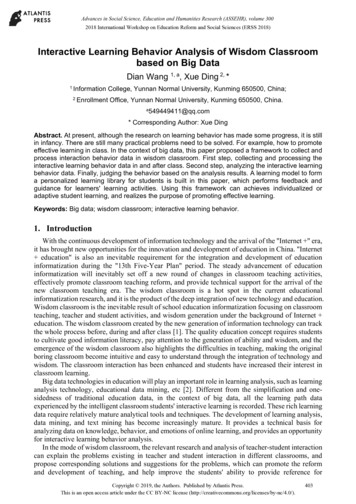
Transcription
Advances in Social Science, Education and Humanities Research (ASSEHR), volume 3002018 International Workshop on Education Reform and Social Sciences (ERSS 2018)Interactive Learning Behavior Analysis of Wisdom Classroombased on Big DataDian Wang 1, a, Xue Ding 2, *1 Information2 EnrollmentCollege, Yunnan Normal University, Kunming 650500, China;Office, Yunnan Normal University, Kunming 650500, China.a549449411@qq.com* Corresponding Author: Xue DingAbstract. At present, although the research on learning behavior has made some progress, it is stillin infancy. There are still many practical problems need to be solved. For example, how to promoteeffective learning in class. In the context of big data, this paper proposed a framework to collect andprocess interaction behavior data in wisdom classroom. First step, collecting and processing theinteractive learning behavior data in and after class. Second step, analyzing the interactive learningbehavior data. Finally, judging the behavior based on the analysis results. A learning model to forma personalized learning library for students is built in this paper, which performs feedback andguidance for learners' learning activities. Using this framework can achieves individualized oradaptive student learning, and realizes the purpose of promoting effective learning.Keywords: Big data; wisdom classroom; interactive learning behavior.1. IntroductionWith the continuous development of information technology and the arrival of the "Internet " era,it has brought new opportunities for the innovation and development of education in China. "Internet education" is also an inevitable requirement for the integration and development of educationinformatization during the "13th Five-Year Plan" period. The steady advancement of educationinformatization will inevitably set off a new round of changes in classroom teaching activities,effectively promote classroom teaching reform, and provide technical support for the arrival of thenew classroom teaching era. The wisdom classroom is a hot spot in the current educationalinformatization research, and it is the product of the deep integration of new technology and education.Wisdom classroom is the inevitable result of school education informatization focusing on classroomteaching, teacher and student activities, and wisdom generation under the background of Internet education. The wisdom classroom created by the new generation of information technology can trackthe whole process before, during and after class [1]. The quality education concept requires studentsto cultivate good information literacy, pay attention to the generation of ability and wisdom, and theemergence of the wisdom classroom also highlights the difficulties in teaching, making the originalboring classroom become intuitive and easy to understand through the integration of technology andwisdom. The classroom interaction has been enhanced and students have increased their interest inclassroom learning.Big data technologies in education will play an important role in learning analysis, such as learninganalysis technology, educational data mining, etc [2]. Different from the simplification and onesidedness of traditional education data, in the context of big data, all the learning path dataexperienced by the intelligent classroom students' interactive learning is recorded. These rich learningdata require relatively mature analytical tools and techniques. The development of learning analysis,data mining, and text mining has become increasingly mature. It provides a technical basis foranalyzing data on knowledge, behavior, and emotions of online learning, and provides an opportunityfor interactive learning behavior analysis.In the mode of wisdom classroom, the relevant research and analysis of teacher-student interactioncan explain the problems existing in teacher and student interaction in different classrooms, andpropose corresponding solutions and suggestions for the problems, which can promote the reformand development of teaching, and help improve the students' ability to provide reference forCopyright 2019, the Authors. Published by Atlantis Press.This is an open access article under the CC BY-NC license 03
Advances in Social Science, Education and Humanities Research (ASSEHR), volume 300classroom teacher-student interaction in the new curriculum reform. Big data technology is integratedinto the analysis of intelligent classroom, which makes teachers use technology to collect, count,process and analyze student learning data, improve students' learning behavior in class, which hasbecome a development trend.2. Interactive Behavior Data Acquisition Model2.1 WeChat-based Classroom Response Analysis SystemDesign a WeChat-based classroom response analysis system to record and analyze the data ofstudents' classroom answers such as response time, response correct rate, topic option distribution,response rate-time curve, response time-score distribution, and feedback on learning analysis report.Realize real-time recording and data analysis of classroom response [3].The response process of the whole system is shown in Figure 1. Teachers and students follow theWeChat platform and bind their personal accounts before class, and then enter the classroom responsesystem. There are teacher's operation menu and student's operation menu. After entering theclassroom, the teacher first initiates a question and the student answers the question. After the studentanswers the question, the data is sent to the background of the system, and the system records thestudent's classroom response, such as response time, response rate, Response correct rate, etc. Thendraw the classroom response curve, and then the analysis results will be sent to the teacher, the teacherdetermines whether to conduct the next teaching session or the knowledge by analyzing the responseresult. If the teaching expectation is not met, can be re-tested after the lecture. If the teachingexpectation is reached, carry out the next stage of teaching, and the response process will end. A classcan have multiple response processes.Fig. 1 Response flowThe response analysis system mainly comprises student response terminal, data collection terminal,data processing terminal, result presentation, teacher sending terminal and the like. The studentresponse terminal is mainly used to enable the student to respond the question or test sent by theteacher; the data collection terminal uses the mobile phone to count the student's answer or test data,save and record the student's answer and test situations; the data processing terminal performs404
Advances in Social Science, Education and Humanities Research (ASSEHR), volume 300statistical analysis and comparison on the student's response and test data, thereby obtaining thestudent's learning statistics; the result presentation refers to the display of the statistical analysisresults or the response analysis data; the teacher sending terminal is the teacher's control of theresponse question, the response process, and the response time.2.2 Interactive Behavior Data Collection ProcessAs shown in Figure 2, after the teacher initiates a question, through the answering process on theanswering interface, the system records the response time of the students in the response process andthe distribution of the answers to the questions. The collected data is the initial data. The positiveanswer rate, response time distribution, answer distribution and response time-score distribution ofthe response are counted in combination with the overall answer record of the whole class.Fig. 2 Interactive behavior data collection process3. Interactive Learning Behavior Analysis of Intelligent Classroom based onBig Data3.1 Learning Analysis based on Big DataThe US "Promoting Teaching and Learning through Education Data Mining and LearningAnalysis" believes that learning analysis is the theory and method of comprehensively applyinginformation science, sociology, computer science, psychology and learning science, through theprocessing and analysis of general education big data, using known models and methods to explainthe major problems affecting learners, assess learners' learning behaviors, and provide artificialadaptive feedback for learners. The report divides the application areas of educational data miningand learning analysis into: learner's knowledge, behavior and experience modeling; learnerdocumentation; domain knowledge modeling; trend analysis [4].3.2 Learning Analysis based on Big DataJ Mater, Chem reviewed the interaction between teachers and students in the wisdom classroommode [5]. Weikai Xie, Yuanchun Shi, and Guanyou Xu discussed the characteristics of teache-studentinteraction in this mode through the exploration of the wisdom classroom teaching mode [6]; Julie B,Jeff C proposed that the key to construct effective teacher-student interaction in the wisdomclassroom mode lies in teacher inspiration and student questioning [7]. Wang Xiaochen et al.combined the characteristics of wisdom classroom, designed and developed a class interactiveobservation tool for wisdom classrooms, which is divided into 5 factors, including basic data,classroom types, classroom related equipments, classroom interaction steps of the process conditions,and the help of wisdom classroom conditions to classroom interaction [8]. Based on constructing thetheoretical framework of teacher-student interaction, Xu Enqin et al. proposed strategies such asstudent-centered learning environment, respect for individual differences, and transformation ofnetwork dependence [9].3.3 Learning Analysis based on Big DataBased on determining the goal of interactive learning behavior analysis, taking a course as anexample, constructing an interactive learning behavior data model for in and after class, as shown inFigure 3, and collecting data, then from left to right, top to bottom, analyzing and modeling the405
Advances in Social Science, Education and Humanities Research (ASSEHR), volume 300interactive learning behavior. Following the construction idea of the analysis model and theinteractive learning process model, the horizontal flow of the analysis process is divided into twoparts: the cluster analysis of interactive learning behavior, the correlation analysis between learningbehavior and learning effect. According to the problem-solving process, the vertical process of theinteractive learning behavior analysis model is divided into data processing, method selection andanalysis process, result output, etc. Finally, the analysis results are visualized to guide the learningbehavior, to achieve personalized or adaptive learning, and to build a learning model based on wisdomclassrooms.Fig. 3 Interactive learning behavior analysis model3.4 Learning Analysis based on Big DataAs shown in Figure 4, the collected source data may be redundant, incomplete, and noisy. Thedata needs to be pre-processed before analysis. Interactive learning behavior data preprocessinggenerally includes data deduplication, denoising, conversion, missing processing, etc.Fig. 4 Interactive learning behavior data preprocessing406
Advances in Social Science, Education and Humanities Research (ASSEHR), volume 3003.5 Analysis Results Visualization and ApplicationPresenting the final behavioral analysis results to learners, teachers, and other outcome consumersis an important part of the interactive learning behavior analysis process. The representations of theresults mainly include line graphs, histograms, pie charts, scatter plots, radar charts, etc. And thespecific analysis results are presented to learners, teachers, etc. in an intuitive and easy-to-understandway, enabling them to quickly understand the results of the analysis.By observing the results of behavioral analysis, it is possible to help learners to carry out selfawareness, self-reflection and the constructing of meaning, thereby guiding learning behavior designand achieving personalized or adaptive learning. The teacher can re-set the learning path for thelearner based on the feedback of the analysis results. Through the interactive feedback, the learner'slearning situation can be further grasped, and the learning model can be constructed according to thedifferent learning levels of the learner.4. Literature References Analysis-based Learning Model DesignAs shown in Figure 5, applying the classroom response system designed before, collecting thepersonalized interactive information of students and doing data mining, forming a personalizedlearning library for students, including courseware library, answering library, task library, projectlibrary, teaching strategy library, etc. [10], and constantly updating and maintaining the resourcelibrary to realize the recommendation, mentoring, online homework correction, online test, study planrecommendation, evaluation exchange and other services for students' learning content.Fig. 5 Learning modelReferences[1]. Xu Lifei: Design and Application of Wisdom Classroom Teaching Mode under Big DataEnvironment (Master of Education, Hebei Normal University, China 2018).[2]. Wang Linli: Design of online learning early warning mechanism based on big data (Master ofScience, Jiangsu Normal University, China 2017).[3]. Cao Shuaixing: Design and Implementation of Classroom Response Analysis System Based onWeChat Public Platform (Master of Education, Huazhong Normal University, China 2017).[4]. Zhou Yan: Study on the interactive behavior of classroom teaching under the informationtechnology teaching environment (Master of Science, Huazhong Normal University, China2013).[5]. J Mate, Chem. Enzyme-responsive materials: a New Class of Smart Biomaterials. Journal ofMaterials Chemistry. (2006).407
Advances in Social Science, Education and Humanities Research (ASSEHR), volume 300[6]. Weikai Xie, Yuanchun Shi, Guanyou Xu. Smart Classroom - an Intelligent Environment forTele-education. Advances in Multimedia Information Processing. (2001).[7]. Julie B, Jeff C, Marshall. Interactions Between Classroom Discourse, Teacher Questioning, andStudent Cognitive Engagement in Middle School Science. Journal of Science Teacher Education.(2013).[8]. Wang Xiaochen, Jiang Shaochan, Huang Ronghuai. Study on classroom interactive observationtools for primary and secondary schools oriented to intelligent classrooms. Journal ofElectrotechnical Education. (2015), p. 49-53.[9]. Xu Enqin, Xu Lianrong, Cui Guangzuo. Study on Individual Differences of Teacher-StudentInteraction -- A Case Study and Analysis Based on Flipping Classroom. China Electro-chemicalEducation. (2016), p. 67-73.[10].Cheng Changpin, Yan Yilin. Research on personalized learning model of network teachingplatform. Journal of Guangdong Second Normal University. Vol. 37 (2017) No. 5, p. 90.408
interactive learning behavior analysis model is divided into data processing, method selection and analysis process, result output, etc. Finally, the analysis results are visualized to guide the learning behavior, to achieve personalized or adaptive learning, and to build a learning model based on wisdom cla
